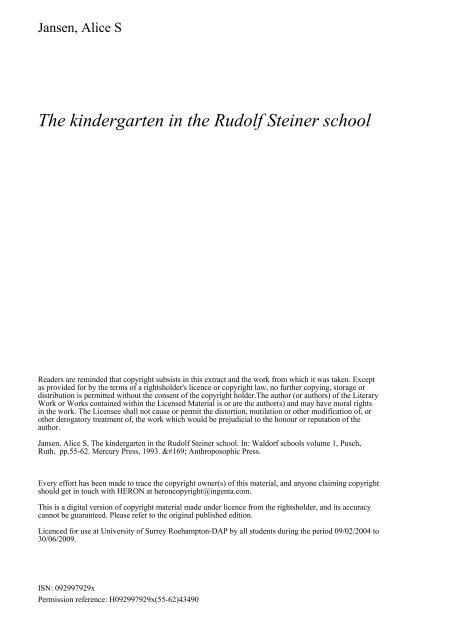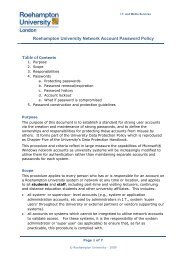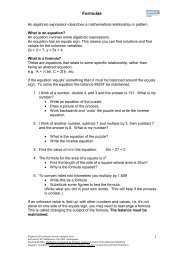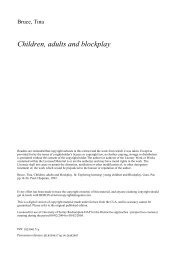The kindergarten in the Rudolf Steiner school - StudentZone
The kindergarten in the Rudolf Steiner school - StudentZone
The kindergarten in the Rudolf Steiner school - StudentZone
Create successful ePaper yourself
Turn your PDF publications into a flip-book with our unique Google optimized e-Paper software.
Jansen, Alice S<br />
<strong>The</strong> <strong>k<strong>in</strong>dergarten</strong> <strong>in</strong> <strong>the</strong> <strong>Rudolf</strong> Ste<strong>in</strong>er <strong>school</strong><br />
Readers are rem<strong>in</strong>ded that copyright subsists <strong>in</strong> this extract and <strong>the</strong> work from which it was taken. Except<br />
as provided for by <strong>the</strong> terms of a rightsholder's licence or copyright law, no fur<strong>the</strong>r copy<strong>in</strong>g, storage or<br />
distribution is permitted without <strong>the</strong> consent of <strong>the</strong> copyright holder.<strong>The</strong> author (or authors) of <strong>the</strong> Literary<br />
Work or Works conta<strong>in</strong>ed with<strong>in</strong> <strong>the</strong> Licensed Material is or are <strong>the</strong> author(s) and may have moral rights<br />
<strong>in</strong> <strong>the</strong> work. <strong>The</strong> Licensee shall not cause or permit <strong>the</strong> distortion, mutilation or o<strong>the</strong>r modification of, or<br />
o<strong>the</strong>r derogatory treatment of, <strong>the</strong> work which would be prejudicial to <strong>the</strong> honour or reputation of <strong>the</strong><br />
author.<br />
Jansen, Alice S, <strong>The</strong> <strong>k<strong>in</strong>dergarten</strong> <strong>in</strong> <strong>the</strong> <strong>Rudolf</strong> Ste<strong>in</strong>er <strong>school</strong>. In: Waldorf <strong>school</strong>s volume 1, Pusch,<br />
Ruth, pp.55-62. Mercury Press, 1993. © Anthroposophic Press.<br />
Every effort has been made to trace <strong>the</strong> copyright owner(s) of this material, and anyone claim<strong>in</strong>g copyright<br />
should get <strong>in</strong> touch with HERON at heroncopyright@<strong>in</strong>genta.com.<br />
This is a digital version of copyright material made under licence from <strong>the</strong> rightsholder, and its accuracy<br />
cannot be guaranteed. Please refer to <strong>the</strong> orig<strong>in</strong>al published edition.<br />
Licenced for use at University of Surrey Roehampton-DAP by all students dur<strong>in</strong>g <strong>the</strong> period 09/02/2004 to<br />
30/06/2009.<br />
ISN: 092997929x<br />
Permission reference: H092997929x(55-62)43490
K<strong>in</strong>dergarten <strong>in</strong> <strong>the</strong> <strong>Rudolf</strong> Ste<strong>in</strong>er School<br />
Most of our children no longer live, as <strong>in</strong> <strong>the</strong> olden days, on<br />
large farms where, with <strong>the</strong>ir numerous bro<strong>the</strong>rs and sisters,<br />
<strong>the</strong>y helped <strong>the</strong>ir mo<strong>the</strong>r <strong>in</strong> <strong>the</strong> house and <strong>the</strong>ir fa<strong>the</strong>r and<br />
<strong>the</strong> farm hands <strong>in</strong> <strong>the</strong> barns and fields. <strong>The</strong>y loved <strong>the</strong>ir pets.<br />
<strong>The</strong>y helped care for cows and horses, pigs and poultry, and<br />
shared <strong>in</strong> <strong>the</strong> thrill<strong>in</strong>g activities of seed time and harvest. In<br />
<strong>the</strong> even<strong>in</strong>gs, <strong>the</strong>y used to play by <strong>the</strong> fireside or listen to<br />
stories told by parents or neighbors or by strangers wel-<br />
comed to <strong>the</strong>ir hospitable hearths.<br />
This sort of life, of course, offered a most natural and<br />
healthful grow<strong>in</strong>g toward <strong>the</strong> time when a child can safely<br />
beg<strong>in</strong> to use his th<strong>in</strong>k<strong>in</strong>g powers at <strong>the</strong> age of six or seven<br />
years. For a child who is lucky enough to have a joyful,<br />
natural family life, this would be <strong>the</strong> ideal moment to start<br />
go<strong>in</strong>g to <strong>school</strong>.<br />
However, <strong>in</strong> <strong>the</strong>se days, our strenuous, high-geared city<br />
life—with its small families, broken families, where grown-<br />
ups are <strong>in</strong> bus<strong>in</strong>ess and often away from home—has robbed<br />
our children of that natural way of liv<strong>in</strong>g, that chance to learn<br />
wholesomely by “imitation and example”. <strong>The</strong>se are <strong>Rudolf</strong><br />
Ste<strong>in</strong>er’s “magic words” for <strong>the</strong> way a little child should<br />
learn dur<strong>in</strong>g his first six or seven years. He po<strong>in</strong>ted out that<br />
though it is quite possible for a child to th<strong>in</strong>k and use his<br />
memory before this time, his later life will be more normal<br />
and healthy, if <strong>in</strong> his early years his forces are allowed to pour<br />
<strong>in</strong>to just grow<strong>in</strong>g, if his “learn<strong>in</strong>g” is allowed its natural<br />
development through imitation.<br />
But for this natural process of just grow<strong>in</strong>g, and of learn<strong>in</strong>g<br />
by imitation and example, <strong>the</strong>re must be a rich background<br />
of th<strong>in</strong>gs to imitate and a health-giv<strong>in</strong>g environment. And so<br />
<strong>the</strong> <strong>k<strong>in</strong>dergarten</strong> <strong>in</strong> a <strong>Rudolf</strong> Ste<strong>in</strong>er School is not a sort of<br />
lower first grade where “learn<strong>in</strong>g” as such is started. Instead,<br />
it tries to give <strong>the</strong> little children as much as possible of that<br />
55
experience and background which our modern way of liv<strong>in</strong>g<br />
has taken away from <strong>the</strong>m.<br />
Though our seeds must be planted <strong>in</strong> pots of earth on a<br />
sunny w<strong>in</strong>dow sill, <strong>the</strong>se little gardens are cared for and<br />
watered each day (sometimes even to <strong>the</strong> po<strong>in</strong>t of destruc-<br />
tion). <strong>The</strong> children play with <strong>the</strong>ir barn and t<strong>in</strong>y toy animals<br />
on <strong>the</strong> floor; <strong>the</strong> surround<strong>in</strong>g hedges and fences and<br />
churches and villages are all made of oddly shaped and<br />
varicolored blocks ga<strong>the</strong>red here and <strong>the</strong>re from left-overs <strong>in</strong><br />
<strong>the</strong> carpenter shops of friends. We f<strong>in</strong>d that <strong>the</strong> geometric,<br />
rigid forms of <strong>the</strong> usual commercial blocks have a crystalliz-<br />
<strong>in</strong>g effect on <strong>the</strong> imag<strong>in</strong>ation and offer few possibilities for<br />
build<strong>in</strong>g. On <strong>the</strong> o<strong>the</strong>r hand, <strong>the</strong> varied, more or less fluid<br />
curves and sizes and clear colors of our blocks suggest<br />
<strong>in</strong>f<strong>in</strong>ite possibilities and stimulate <strong>the</strong> imag<strong>in</strong>ation to vast<br />
heights of creativeness. For “<strong>the</strong> work of <strong>the</strong> imag<strong>in</strong>ation<br />
moulds and forms <strong>the</strong> bra<strong>in</strong>.”<br />
We have our housework, too, tak<strong>in</strong>g turns on each of <strong>the</strong><br />
jobs. It may be more fun to feed <strong>the</strong> fish and water <strong>the</strong> plants<br />
than to mop <strong>the</strong> floor, but we “take it as it comes”—as <strong>the</strong><br />
mo<strong>the</strong>r sheep said to her lambs about <strong>the</strong> different k<strong>in</strong>ds of<br />
grass.<br />
When <strong>the</strong> time comes for mid-morn<strong>in</strong>g lunch, though it be<br />
only cold water <strong>in</strong> a paper cup and a crisp graham cracker,<br />
we eat toge<strong>the</strong>r at a long family table, made by jo<strong>in</strong><strong>in</strong>g<br />
several small ones, and each child takes his special place. We<br />
take turns choos<strong>in</strong>g <strong>the</strong> center piece: plant or gold-fish bowl.<br />
We wait until <strong>the</strong> one, whose day it is, comes to pass <strong>the</strong><br />
cracker basket to each of us, at <strong>the</strong> left side; we fold our hands<br />
while we say our verse. After lunch we have our story. <strong>The</strong><br />
rest<strong>in</strong>g time comes when needed and <strong>the</strong> children lie still and<br />
listen to quiet music.<br />
More chances to share and take turns come dur<strong>in</strong>g <strong>the</strong><br />
outdoor playtime and we try to take <strong>the</strong> consequences of our<br />
own deeds as soon as <strong>the</strong>y come <strong>in</strong>to be<strong>in</strong>g, <strong>in</strong> order to learn<br />
<strong>the</strong> reaction of <strong>the</strong> world before <strong>the</strong> world gives it to us, as<br />
Dr. Ste<strong>in</strong>er once suggested.<br />
56
We try to br<strong>in</strong>g <strong>the</strong> whole be<strong>in</strong>g <strong>in</strong>to action <strong>in</strong> all we do,<br />
from eurythmy to tell<strong>in</strong>g fairy tales. We must always remem-<br />
ber that <strong>in</strong> artistic activity <strong>the</strong> whole be<strong>in</strong>g actually does<br />
come <strong>in</strong>to play. A phlegmatic and melancholic child is helped<br />
by an overabundance of outgo<strong>in</strong>g, artistic expression such<br />
as musical activity, s<strong>in</strong>g<strong>in</strong>g and pa<strong>in</strong>t<strong>in</strong>g. <strong>The</strong> choleric and<br />
sangu<strong>in</strong>e children need <strong>the</strong> more formative, unify<strong>in</strong>g quali-<br />
ties acquired <strong>in</strong> model<strong>in</strong>g, draw<strong>in</strong>g and handwork. Eu-<br />
rythmy also is used to help <strong>in</strong> balanc<strong>in</strong>g temperamental<br />
difficulties and can be adapted at any moment to suit <strong>the</strong><br />
immediate need. “However great <strong>the</strong> need for improvement<br />
<strong>the</strong> teacher may f<strong>in</strong>d <strong>in</strong> <strong>the</strong> child, he will not fail to see, <strong>in</strong><br />
exist<strong>in</strong>g th<strong>in</strong>gs <strong>the</strong>mselves, <strong>the</strong> embryo of <strong>the</strong> future. At <strong>the</strong><br />
same time he knows that <strong>in</strong> all th<strong>in</strong>gs becom<strong>in</strong>g, <strong>the</strong>re must<br />
be growth and evolution. Hence he will perceive <strong>in</strong> <strong>the</strong><br />
present <strong>the</strong> seeds of transformation and of growth. He <strong>in</strong>-<br />
vents no programs—he reads <strong>the</strong>m out of what is <strong>the</strong>re.<br />
What he thus reads becomes <strong>in</strong> itself a program, for it bears<br />
<strong>in</strong> itself <strong>the</strong> essence of development. From <strong>the</strong> nature of <strong>the</strong><br />
evolv<strong>in</strong>g human be<strong>in</strong>g, <strong>the</strong> proper po<strong>in</strong>t of view for educa-<br />
tion will result. Perhaps <strong>the</strong> hardest task a <strong>k<strong>in</strong>dergarten</strong><br />
teacher has is to help <strong>the</strong> children who suffer from extremes<br />
of temperament, to acquire self-control, or some balance <strong>in</strong><br />
<strong>the</strong>m. Nor can anyth<strong>in</strong>g give a teacher greater comfort than<br />
an appreciable degree of success <strong>in</strong> this high adventure.” (A<br />
Modern Art of Education by <strong>Rudolf</strong> Ste<strong>in</strong>er).<br />
A few observations of children, known dur<strong>in</strong>g my years<br />
of <strong>k<strong>in</strong>dergarten</strong> teach<strong>in</strong>g, will help to illustrate <strong>the</strong>se words.<br />
One child of five years, ra<strong>the</strong>r pale, with long, brown<br />
braids, slow, plodd<strong>in</strong>g, phlegmatic, overmeticulous, large for<br />
her age, often sat by herself play<strong>in</strong>g with her own separate<br />
treasures, hoard<strong>in</strong>g and satisfied. She had some of <strong>the</strong> qual-<br />
ities of a sett<strong>in</strong>g hen. She was comfortable and placid. But<br />
she was not out-go<strong>in</strong>g enough nor wide enough awake for<br />
her own good. Very soon <strong>the</strong> younger children and <strong>the</strong><br />
high-strung ones (cholerics), and timid ones (melancholics)<br />
came closer under her w<strong>in</strong>g <strong>in</strong> <strong>the</strong> free play time. <strong>The</strong> teacher<br />
57
always tried to keep her bodily active and gave her chances<br />
for dar<strong>in</strong>g to overcome her over-meticulousness. She became<br />
more friendly, almost mo<strong>the</strong>rly, and began to sparkle. She<br />
became happier and more active and noticeably popular<br />
with all <strong>the</strong> children. She was always pleased to be a “special<br />
helper”.<br />
<strong>The</strong>n <strong>the</strong>re was a tall, th<strong>in</strong>, pale, little boy of four with very<br />
light hair and almost translucent sk<strong>in</strong>, an extreme choleric-<br />
sangu<strong>in</strong>e temperament. He had strangely beautiful eyes and<br />
an imag<strong>in</strong>ation which showed him more than most could<br />
see. He had an irregular life at home and never knew where<br />
he was to go or what to do after <strong>k<strong>in</strong>dergarten</strong> hours. He was<br />
<strong>in</strong>secure, lonely and hungry for his mo<strong>the</strong>r. He was very<br />
lov<strong>in</strong>g. On <strong>the</strong> o<strong>the</strong>r hand, he was destructive and had<br />
terrific fits of temper amount<strong>in</strong>g almost to frenzy, dur<strong>in</strong>g<br />
which a veil of hardness would come over his eyes. At such<br />
times his teacher could not look at him directly or make<br />
demands of him, but quietly tak<strong>in</strong>g firm hold of his wrist,<br />
seem<strong>in</strong>g to be unconcerned, talk<strong>in</strong>g to <strong>the</strong> o<strong>the</strong>r children as<br />
occasion demanded, she would assume that he was go<strong>in</strong>g to<br />
do what was required of him and <strong>the</strong>n leave him alone to do<br />
it. Dur<strong>in</strong>g his two and one half years <strong>in</strong> <strong>the</strong> <strong>k<strong>in</strong>dergarten</strong> this<br />
always succeeded. After a while he would quietly creep back<br />
<strong>in</strong>to <strong>the</strong> group and <strong>the</strong>n and only <strong>the</strong>n would be accepted by<br />
<strong>the</strong> o<strong>the</strong>rs. After one of those tantrums had been conquered<br />
<strong>the</strong> teacher would ask him to do some extra task alone, which<br />
would help him to grow whole aga<strong>in</strong>. While act<strong>in</strong>g <strong>in</strong> fairy<br />
tales this child became transformed—noble and poised <strong>in</strong> <strong>the</strong><br />
part of <strong>the</strong> golden pr<strong>in</strong>ce and would conquer any dragons.<br />
He was given both parts <strong>in</strong> <strong>the</strong> little plays—k<strong>in</strong>g and pr<strong>in</strong>ce,<br />
which he found difficult <strong>in</strong> daily life—dragon, witch and<br />
mischief maker, which he most easily lived. With <strong>the</strong> first, he<br />
conquered his difficulties; with <strong>the</strong> second, he became hor-<br />
ribly bored and wanted to give it up! <strong>The</strong>se successes even<br />
helped him to control his unfortunate elim<strong>in</strong>ation habits<br />
which had been caused by his emotional <strong>in</strong>stability.<br />
58
A little, light haired three-year-old-boy, with healthy body<br />
and beautifully formed head had not had much attention nor<br />
<strong>the</strong> usual regularity at home because of <strong>the</strong> busy life his<br />
family led. He had a high-pitched voice, was tense, had<br />
moments of be<strong>in</strong>g a little tired and wistful, but was one of<br />
<strong>the</strong> friendliest and happiest little boys ever known <strong>in</strong> our<br />
<strong>k<strong>in</strong>dergarten</strong>. He was <strong>the</strong> perfect sangu<strong>in</strong>e type. He would<br />
come forward with smil<strong>in</strong>g eyes and hand outstretched to<br />
greet everyone. He learned to play quietly by himself when<br />
necessary, just wait<strong>in</strong>g for whatever was to happen next—a<br />
needed peaceful time without too many impressions. He<br />
sang all our songs ei<strong>the</strong>r with us or by himself with utter joy<br />
and no self-consciousness. <strong>The</strong> scattered attention of this<br />
little sangu<strong>in</strong>e child was creatively taken up by our many<br />
group activities, whereas when left alone his concentration<br />
would be short and more turned <strong>in</strong> on himself.<br />
<strong>The</strong>re was a t<strong>in</strong>y, fragile, delicate-featured little girl four<br />
and a half years old, with large, brown eyes and dark, curly<br />
braids. Her temperament was melancholic. She was very<br />
exact, overcautious, overconscientious and her muscles were<br />
tense. She had younger sisters for whom she probably felt<br />
too responsible and so at <strong>school</strong> she was given little respon-<br />
sibility. She craved approval eagerly but shyly and <strong>the</strong><br />
teacher often gave her a secret, special smile of encourage-<br />
ment. In <strong>the</strong> music time, <strong>the</strong> teacher could make an example<br />
of her ability for <strong>the</strong> class. Mostly through music and eu-<br />
rythmy and fairy tales, she blossomed <strong>in</strong>to a freer, happier<br />
little be<strong>in</strong>g, more naturally sangu<strong>in</strong>e—which is <strong>the</strong> most<br />
normal state for a child.<br />
Ano<strong>the</strong>r little girl of four came to our <strong>school</strong> one day, a few<br />
weeks after <strong>the</strong> fall term started. She had an upright carriage<br />
with firmly built body, round, blue eyes and a sensitive<br />
mouth, which turned down at <strong>the</strong> corners at <strong>the</strong> slightest<br />
rebuff. She had had few children to play with and had been<br />
surrounded by ador<strong>in</strong>g relatives and nurses all her short life.<br />
This was her first experience away from home. She cried<br />
almost <strong>in</strong>cessantly for <strong>the</strong> first week or two of <strong>school</strong>. She<br />
59
called for her nurse who, she evidently thought, would drop<br />
out of <strong>the</strong> sky on demand. <strong>The</strong> teacher required silence from<br />
her only dur<strong>in</strong>g <strong>the</strong> morn<strong>in</strong>g verse and mid-morn<strong>in</strong>g<br />
lunch—o<strong>the</strong>rwise, she appeared to ignore her. It was hard<br />
on <strong>the</strong> o<strong>the</strong>rs but <strong>the</strong>y played <strong>the</strong> game and carried on as<br />
usual. Her cries cont<strong>in</strong>ued: “I want a dr<strong>in</strong>k of water. I want<br />
a dr<strong>in</strong>k of water. I want a dr<strong>in</strong>k of water. I want my nurse to<br />
give it to me.” Teacher: “Your nurse won’t be here until<br />
twelve o’clock. Would you like a dr<strong>in</strong>k of water?” She: “I’m<br />
not a bit thirsty, thank you.” Teacher: “Very well.” After days<br />
of see<strong>in</strong>g <strong>the</strong> o<strong>the</strong>r children put <strong>the</strong>ir hands over <strong>the</strong>ir ears<br />
and hear<strong>in</strong>g <strong>the</strong>m say, “She’s a cry baby,” spaces developed<br />
between her sobs and outcries. Gradually she began to ob-<br />
serve and absorb what was go<strong>in</strong>g on about her, but she<br />
would not jo<strong>in</strong> <strong>in</strong>. Dur<strong>in</strong>g music and eurythmy, she would<br />
keep rhythm with her foot or head unless she saw someone<br />
watch<strong>in</strong>g her. At last her eyes began to smile at her teacher<br />
once <strong>in</strong> awhile. <strong>The</strong>n <strong>the</strong> teacher occasionally took her out-<br />
side <strong>the</strong> room for a few moments and held her <strong>in</strong> her lap and<br />
listened to outpour<strong>in</strong>gs of talk about home. <strong>The</strong>y had be-<br />
come fast friends.<br />
After ten days, when she heard <strong>the</strong> two notes on <strong>the</strong><br />
piano—<strong>the</strong> signal for “circle”—she came to <strong>the</strong> teacher and<br />
took her hand to jo<strong>in</strong> <strong>in</strong>. But she still resisted new th<strong>in</strong>gs a<br />
little longer. By <strong>the</strong> end of three weeks she had accepted<br />
every activity but one, <strong>the</strong> one to mean more to her, eventu-<br />
ally, than anyth<strong>in</strong>g else—eurythmy. This she accepted only<br />
after Christmas. By <strong>the</strong> fourth week she came each day with<br />
glow<strong>in</strong>g face and a more than friendly “good morn<strong>in</strong>g” to<br />
all. But even <strong>the</strong>n remarks of <strong>the</strong> o<strong>the</strong>r children like: “It’s nice<br />
here now, isn’t it? Mary doesn’t cry any more”—made <strong>the</strong><br />
corners of her mouth droop and <strong>the</strong> teacher would hurry to<br />
say: “Oh, no, that was long ago, that’s all over now.” <strong>The</strong>n<br />
Peter: “But why did she cry? That’s ‘silly bus<strong>in</strong>ess’!” Teacher:<br />
“Don’t you remember when you came last year and you<br />
didn’t know us very well?” Peter: “But I didn’t cry like that.”<br />
Teacher: “No, you cried your k<strong>in</strong>d of cry.” Mary looked<br />
60
elieved at that. Peter looked a little sheepish and stopped<br />
argu<strong>in</strong>g. Instead, he took Mary and led her toward <strong>the</strong><br />
colored blocks. “Will you make a castle with me?” he asked.<br />
<strong>The</strong>n she was glad for she had always admired Peter.<br />
Peter’s cry when he was new at <strong>school</strong> had been loud<br />
enough but short lived, not stubborn like Mary’s. He was a<br />
happy, outgo<strong>in</strong>g, friendly child, very large and strong for his<br />
age. His occasional bursts of temper would have been less<br />
frequent if he could have had contact and competition with<br />
children equal to him <strong>in</strong> physical health and vigor. He was<br />
sangu<strong>in</strong>e with occasional choleric spurts. It was a great help<br />
to both Peter and Mary to have to share and to have to<br />
conform to <strong>the</strong> general rhythm of <strong>the</strong> <strong>k<strong>in</strong>dergarten</strong> day. Each<br />
of <strong>the</strong>m, be<strong>in</strong>g an only child, had lived with grown-ups and<br />
had too much adult attention.<br />
Mary, after six months of <strong>school</strong> knew just what every-<br />
body else should do and was <strong>in</strong> danger of be<strong>in</strong>g overhelpful,<br />
almost “bossy”, especially to <strong>the</strong> little boy sitt<strong>in</strong>g near her on<br />
<strong>the</strong> o<strong>the</strong>r side of <strong>the</strong> playhouse.<br />
He was Jonathan, three and a half years old, sturdy,<br />
healthy, with rosy cheeks. Explosively choleric, he was easily<br />
diverted by be<strong>in</strong>g swept <strong>in</strong>to <strong>the</strong> group of <strong>the</strong> older children<br />
whom he unconsciously adored. <strong>The</strong> teacher often started<br />
some “group activity” for such moments—someth<strong>in</strong>g really<br />
creative for him to imitate. One of <strong>the</strong> th<strong>in</strong>gs he liked to<br />
imitate was pa<strong>in</strong>t<strong>in</strong>g and he would often sit quite peacefully<br />
with his three bowls of clear colors, “fire color”, “sh<strong>in</strong><strong>in</strong>g sun<br />
color” and “sky blue”, for half an hour at a time entirely<br />
oblivious of <strong>the</strong> o<strong>the</strong>rs. “Softly, softly,” with his big brush he<br />
would pa<strong>in</strong>t a whole paper fiery red, his cheeks aglow with<br />
<strong>the</strong> joy of it. <strong>The</strong> o<strong>the</strong>r children were just as pleased with his<br />
pa<strong>in</strong>t<strong>in</strong>g as he was and <strong>the</strong>y came to warm <strong>the</strong>ir hands over<br />
it. His absorption and achievement <strong>in</strong> pa<strong>in</strong>t<strong>in</strong>g helped him<br />
to f<strong>in</strong>d himself, while <strong>the</strong> group activities taught him socia-<br />
bility. It was a good experience for both Mary and Jonathan<br />
to be near each o<strong>the</strong>r. <strong>The</strong>y helped to wear each o<strong>the</strong>r’s<br />
(choleric) corners off! Mary even got over hav<strong>in</strong>g<br />
61
“opposititis” at home where she had once been a real prob-<br />
lem.<br />
<strong>The</strong>se are only a few illustrations but <strong>the</strong> teacher hopes<br />
<strong>the</strong>y have given some idea of what a <strong>Rudolf</strong> Ste<strong>in</strong>er k<strong>in</strong>der-<br />
garten tries to br<strong>in</strong>g to its t<strong>in</strong>y pupils.<br />
After a year or two, through close, daily rhythmic activity<br />
toge<strong>the</strong>r, <strong>the</strong> children have learned <strong>the</strong> right k<strong>in</strong>d of sponta-<br />
neity, how to work <strong>in</strong> a group, and some measure of self-con-<br />
trol. <strong>The</strong>y are now ready to beg<strong>in</strong> to learn and to use <strong>the</strong>ir<br />
memories—<strong>in</strong> <strong>the</strong> First Grade—which has been <strong>the</strong>ir mecca<br />
for some time.<br />
(1941) Alice Smith Jansen<br />
On <strong>the</strong> Moral Education of<br />
Younger Children*<br />
When we attempt to speak on moral education, we feel<br />
that this may not be done lightly but that our thoughts must<br />
be deeply rooted. We even have a sense of strong discomfi-<br />
ture when we speak on such a <strong>the</strong>me; a lifetime is <strong>in</strong>sufficient<br />
for acquir<strong>in</strong>g knowledge of <strong>the</strong> human be<strong>in</strong>g, upon which<br />
alone morality can be founded.<br />
We realize that it is not sufficient to follow <strong>in</strong> <strong>the</strong> steps of<br />
<strong>the</strong> natural sciences only. Knowledge of <strong>the</strong> body alone is not<br />
enough. In order to be able to work <strong>in</strong> a way which is morally<br />
fruitful, knowledge of <strong>the</strong> soul-spiritual be<strong>in</strong>g of man is<br />
necessary, and we feel that we stand only at <strong>the</strong> beg<strong>in</strong>n<strong>in</strong>g of<br />
true research <strong>in</strong> this realm.<br />
A fur<strong>the</strong>r difficulty consists <strong>in</strong> our be<strong>in</strong>g unable to have<br />
any <strong>in</strong>fluence on an <strong>in</strong>dividual human be<strong>in</strong>g so long as we<br />
* Translated by Helen S. Belsterli from <strong>the</strong> bi-monthly magaz<strong>in</strong>e<br />
Erziehungskunst published by <strong>the</strong> teachers of <strong>the</strong> Waldorf School, Stuttgart,<br />
1935.<br />
62











